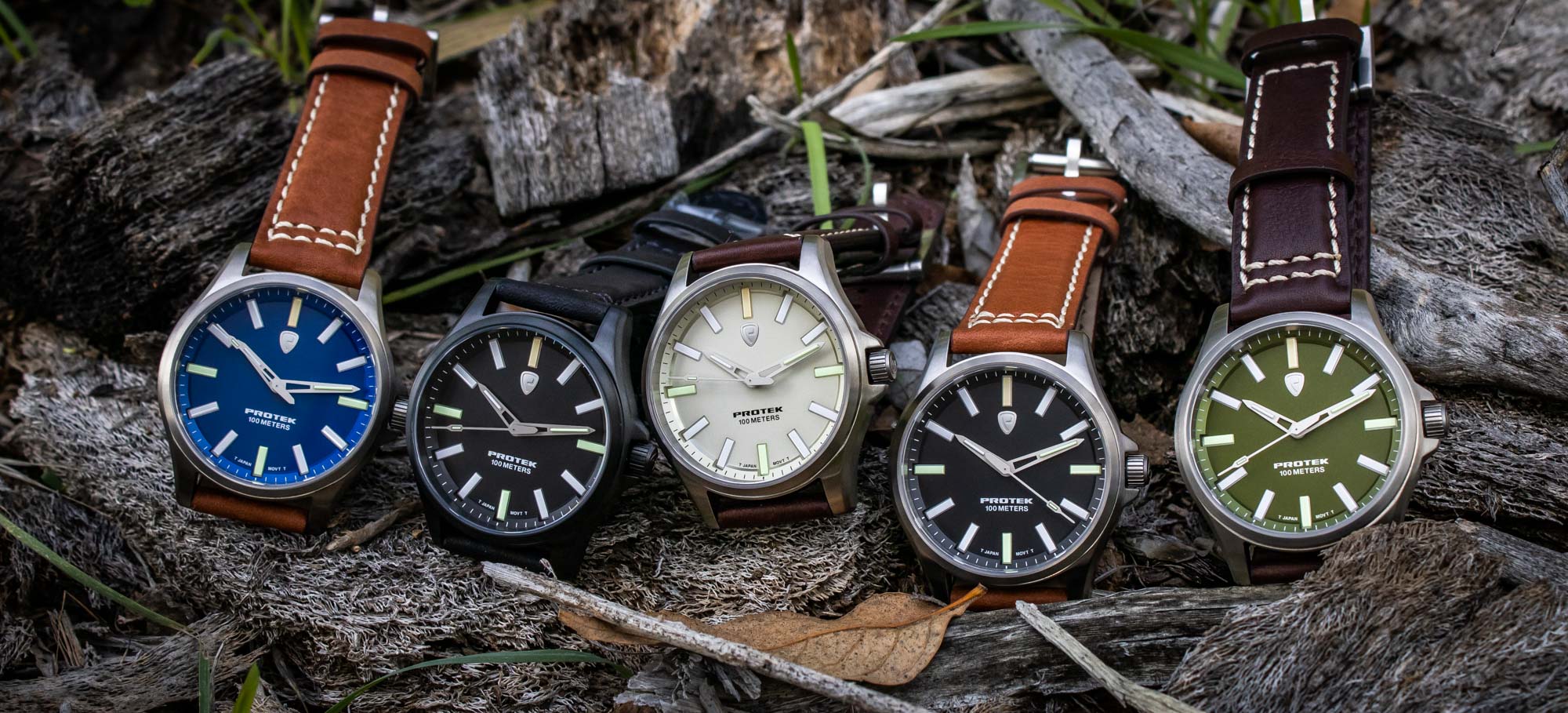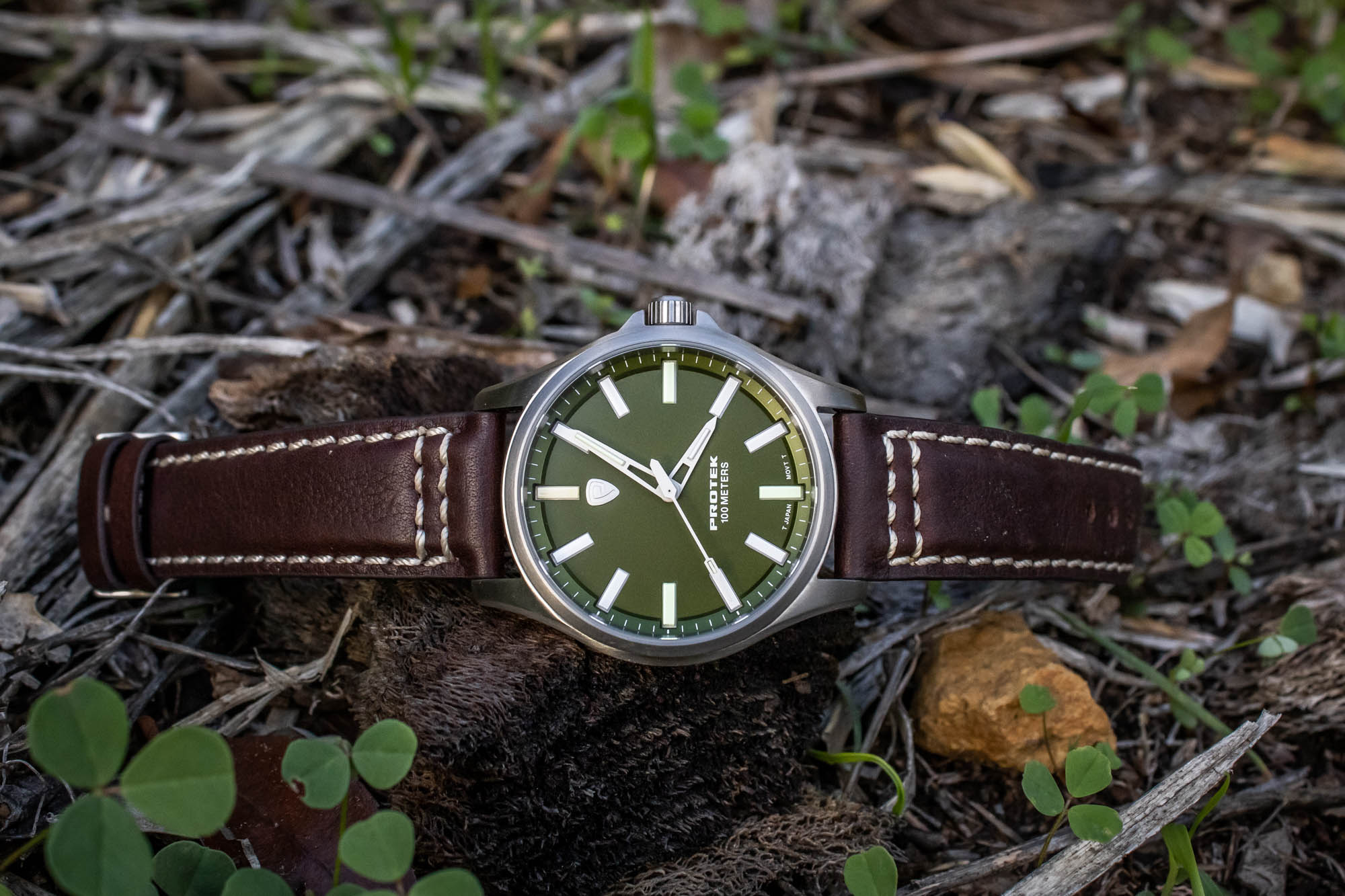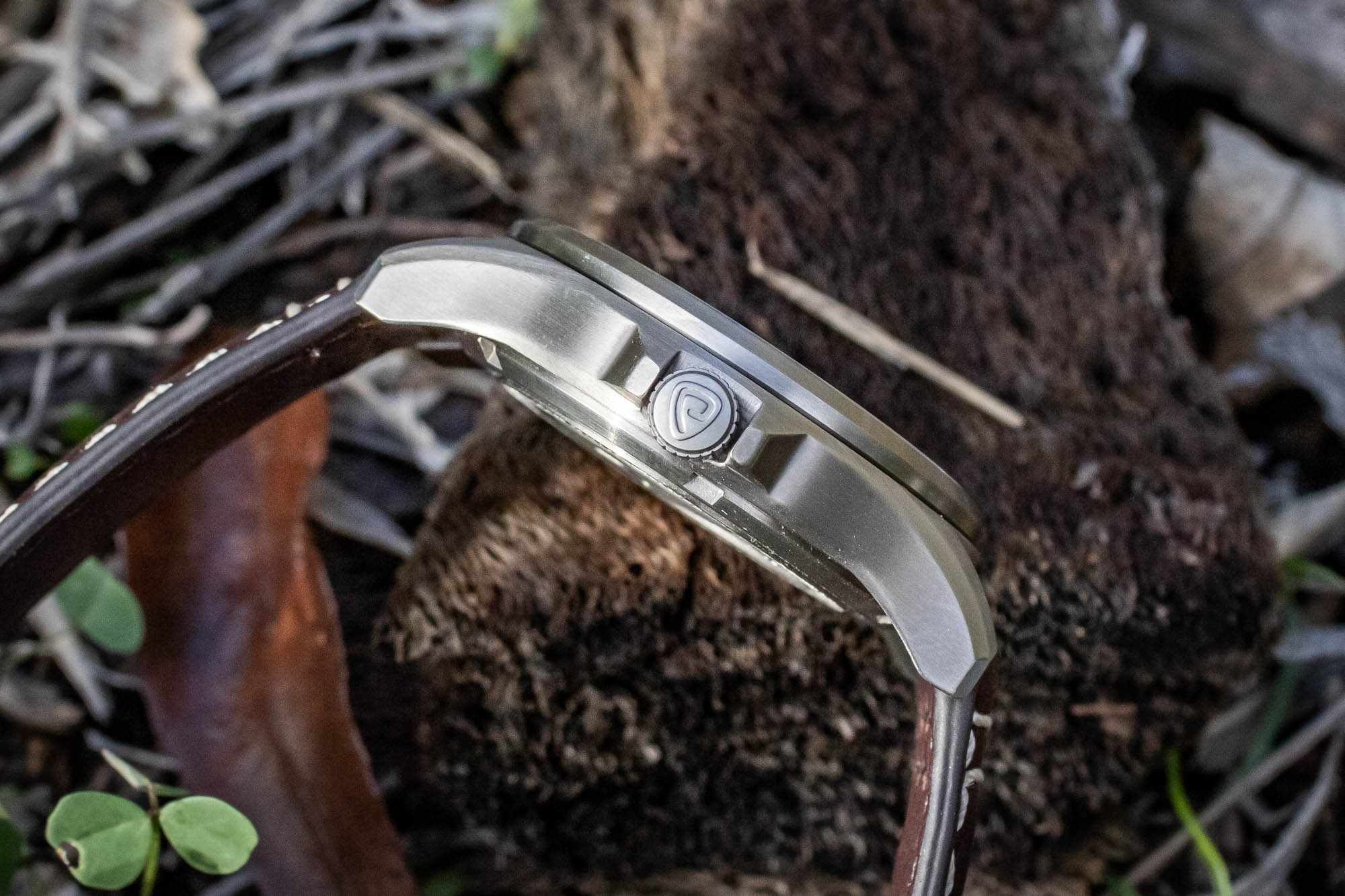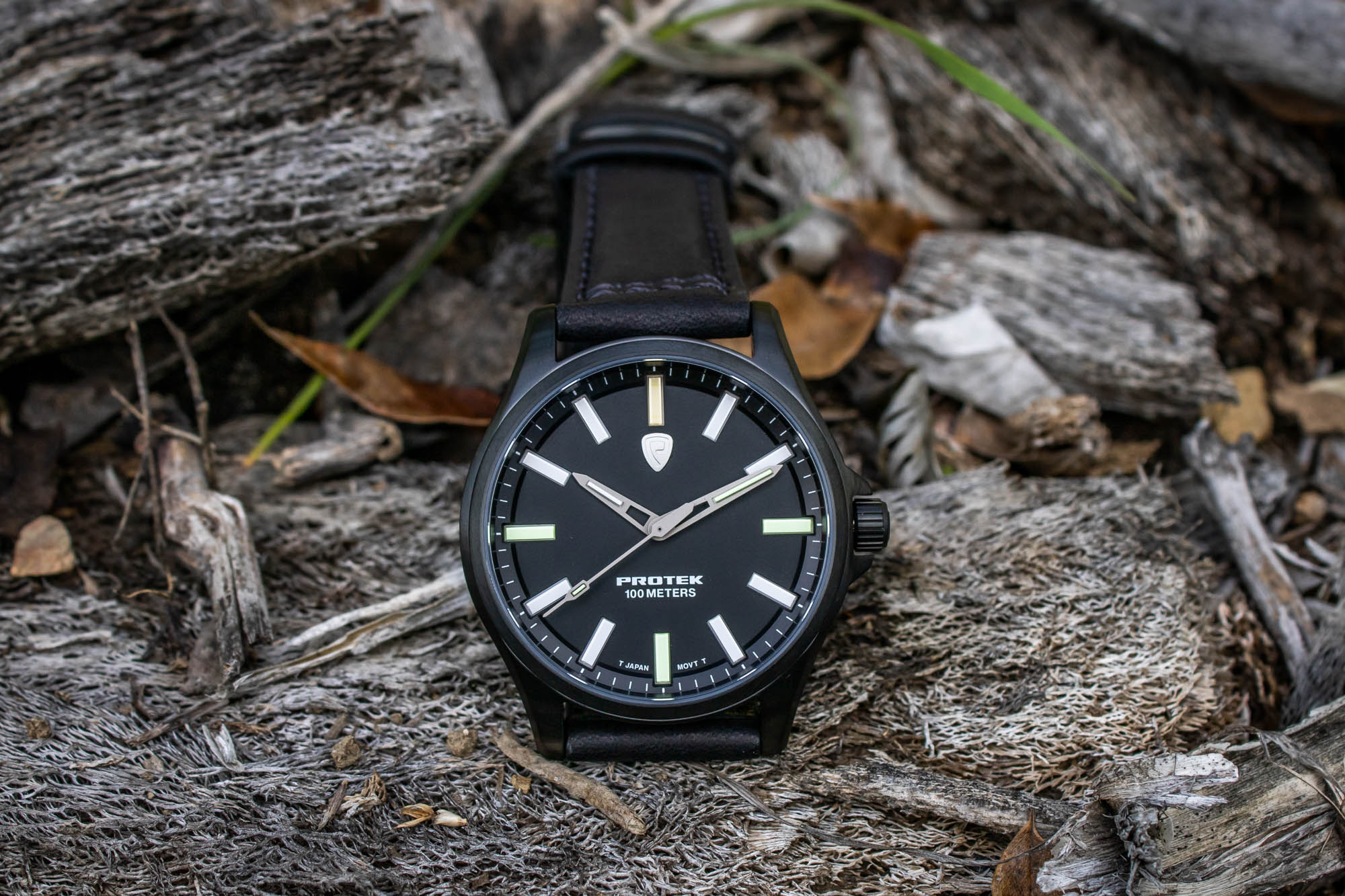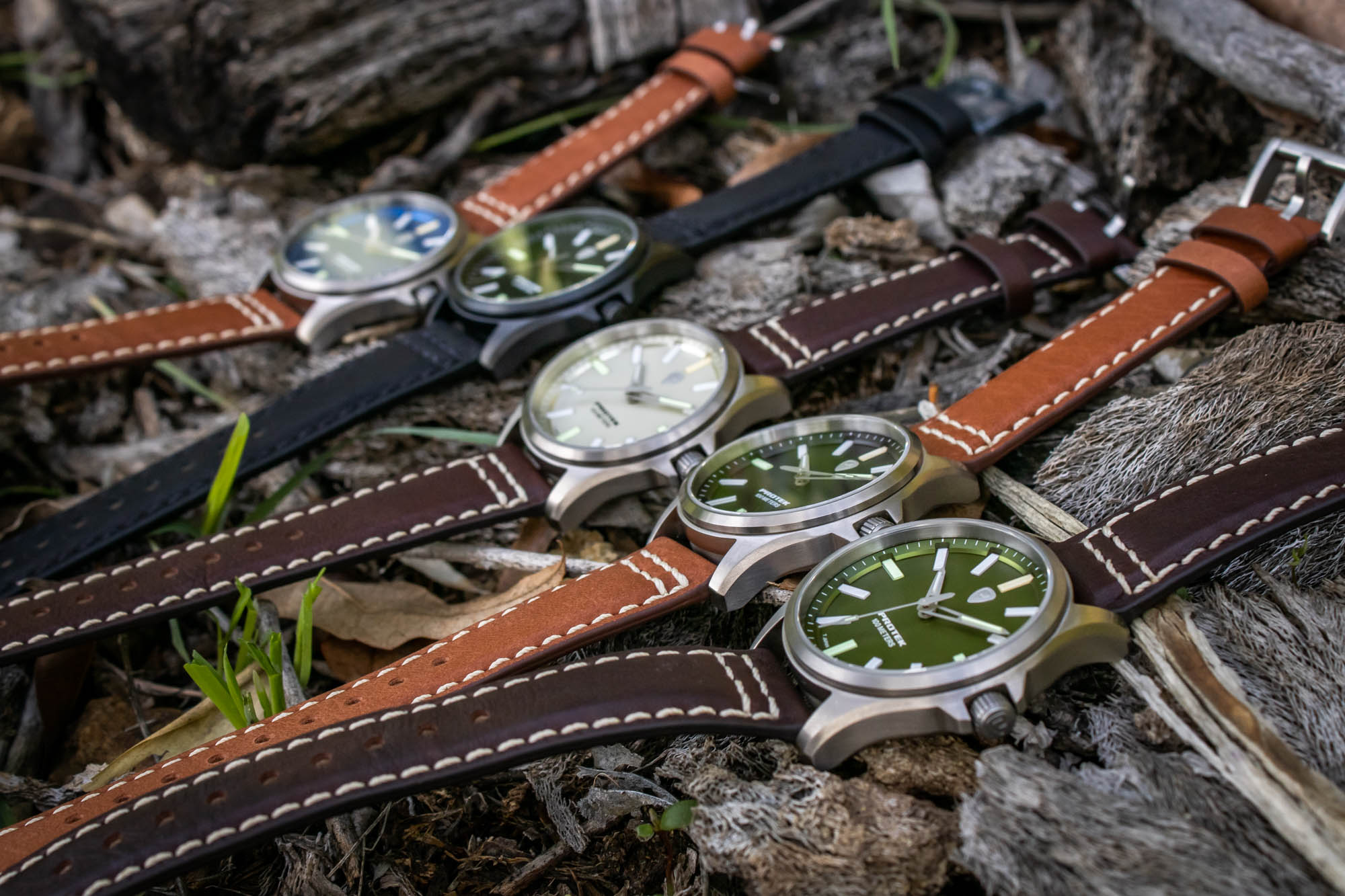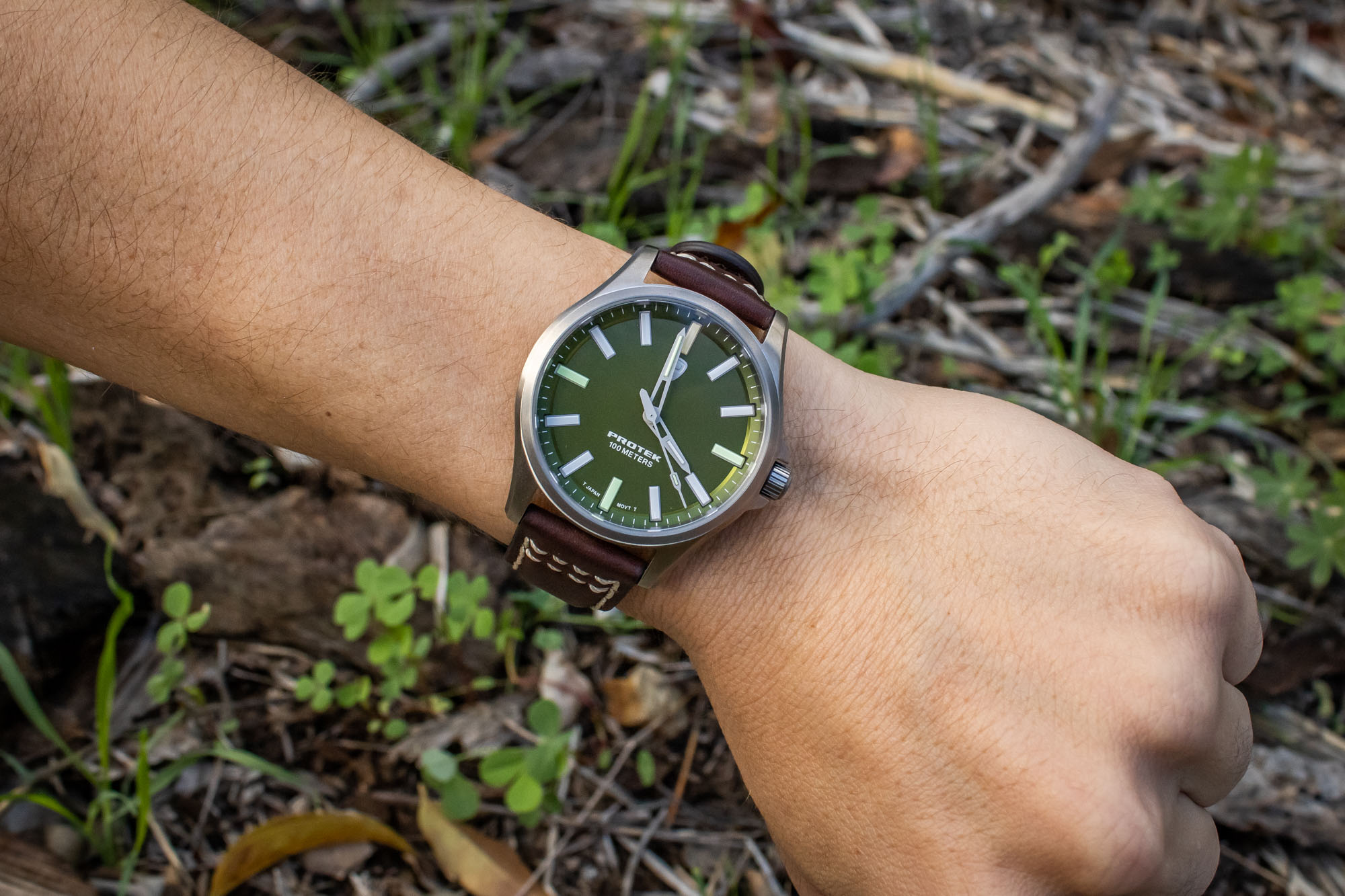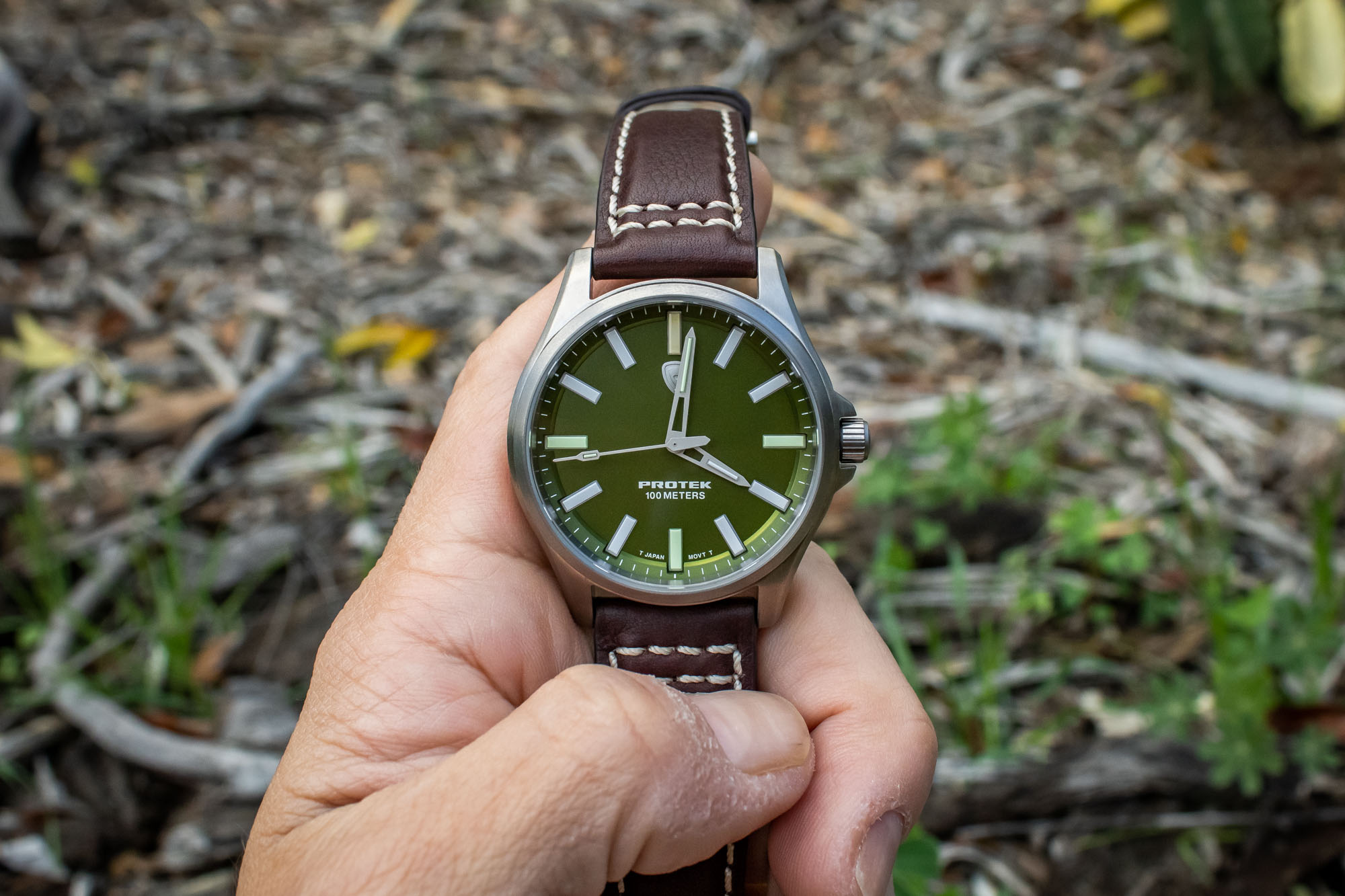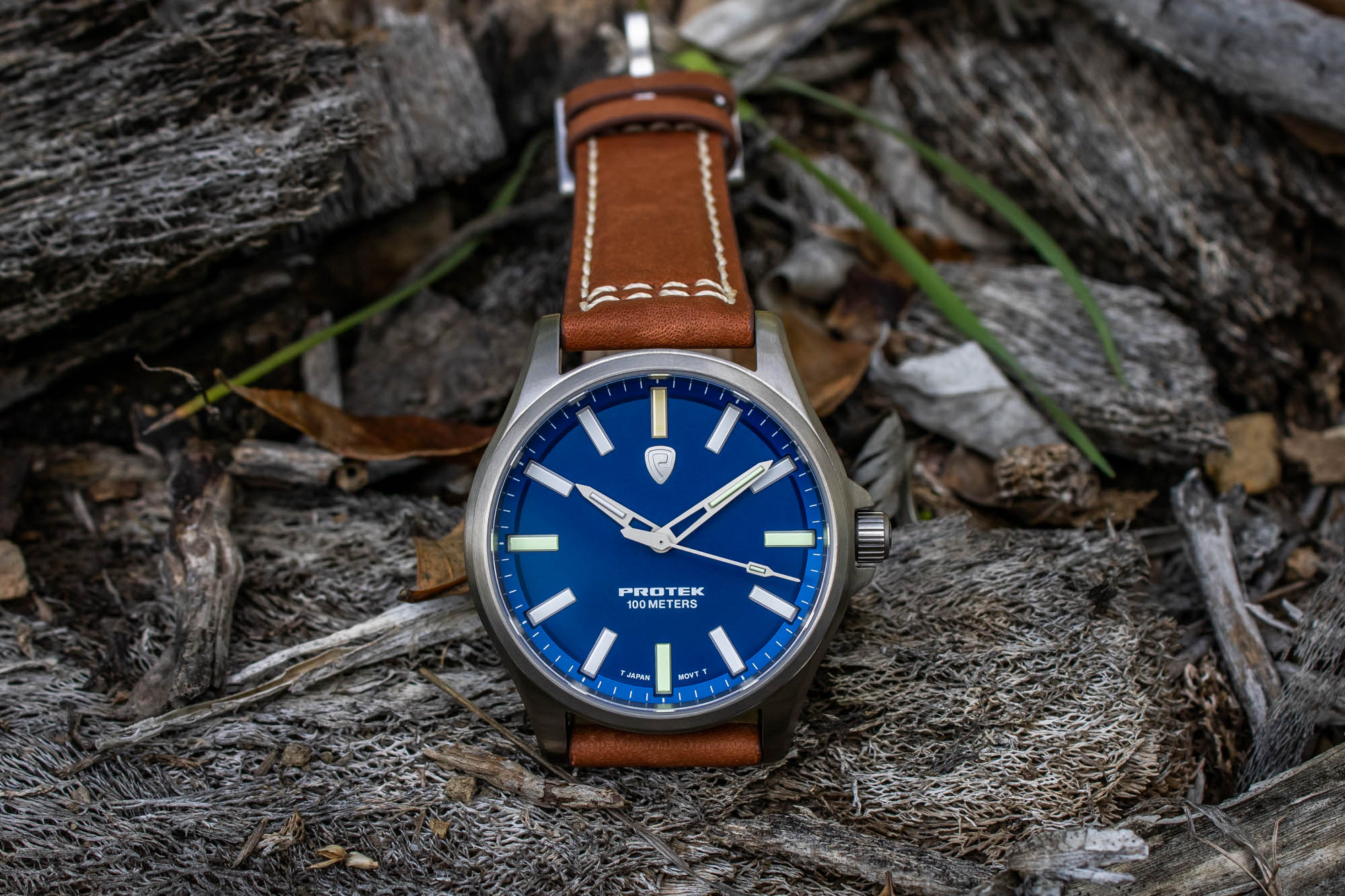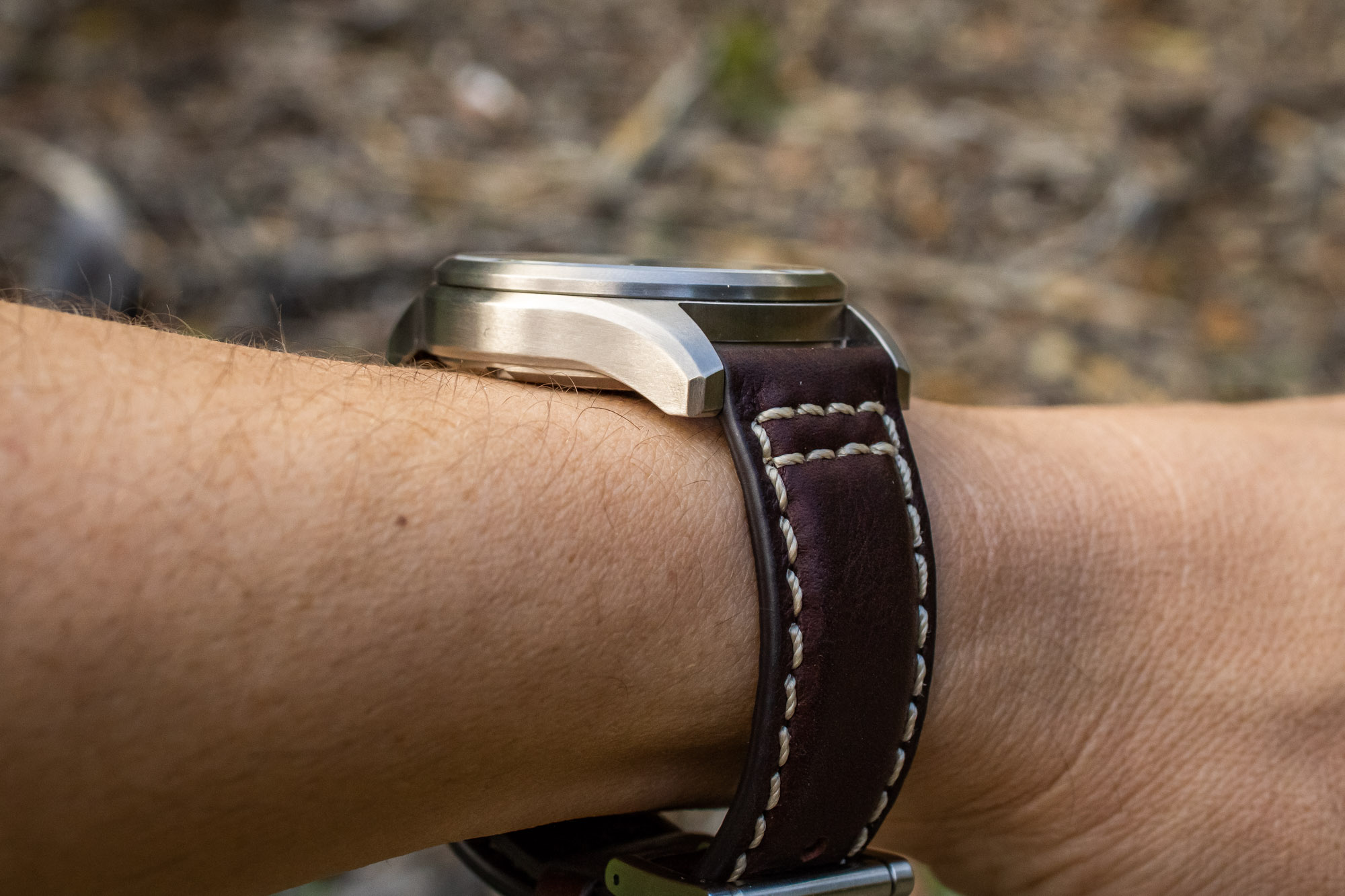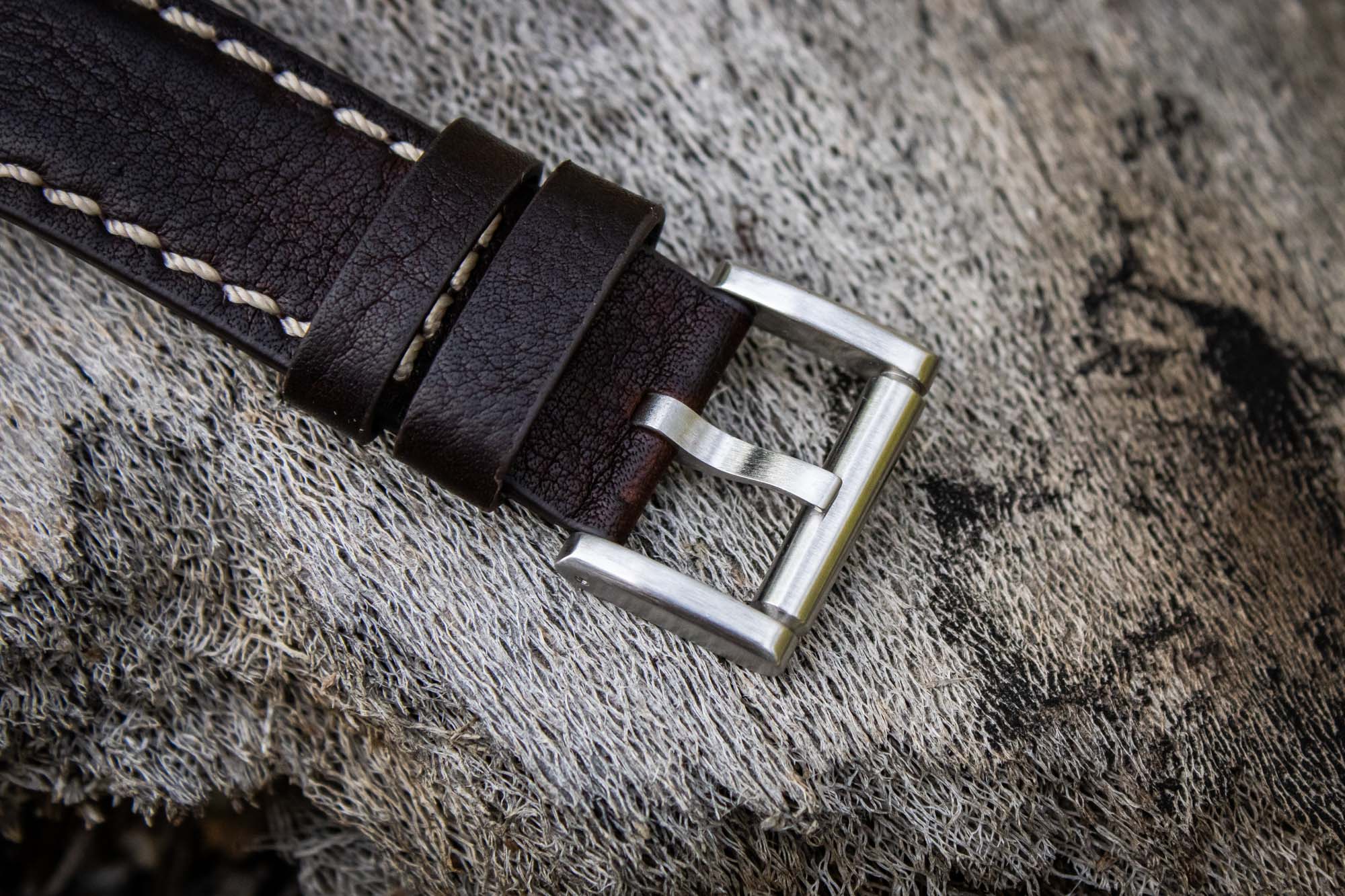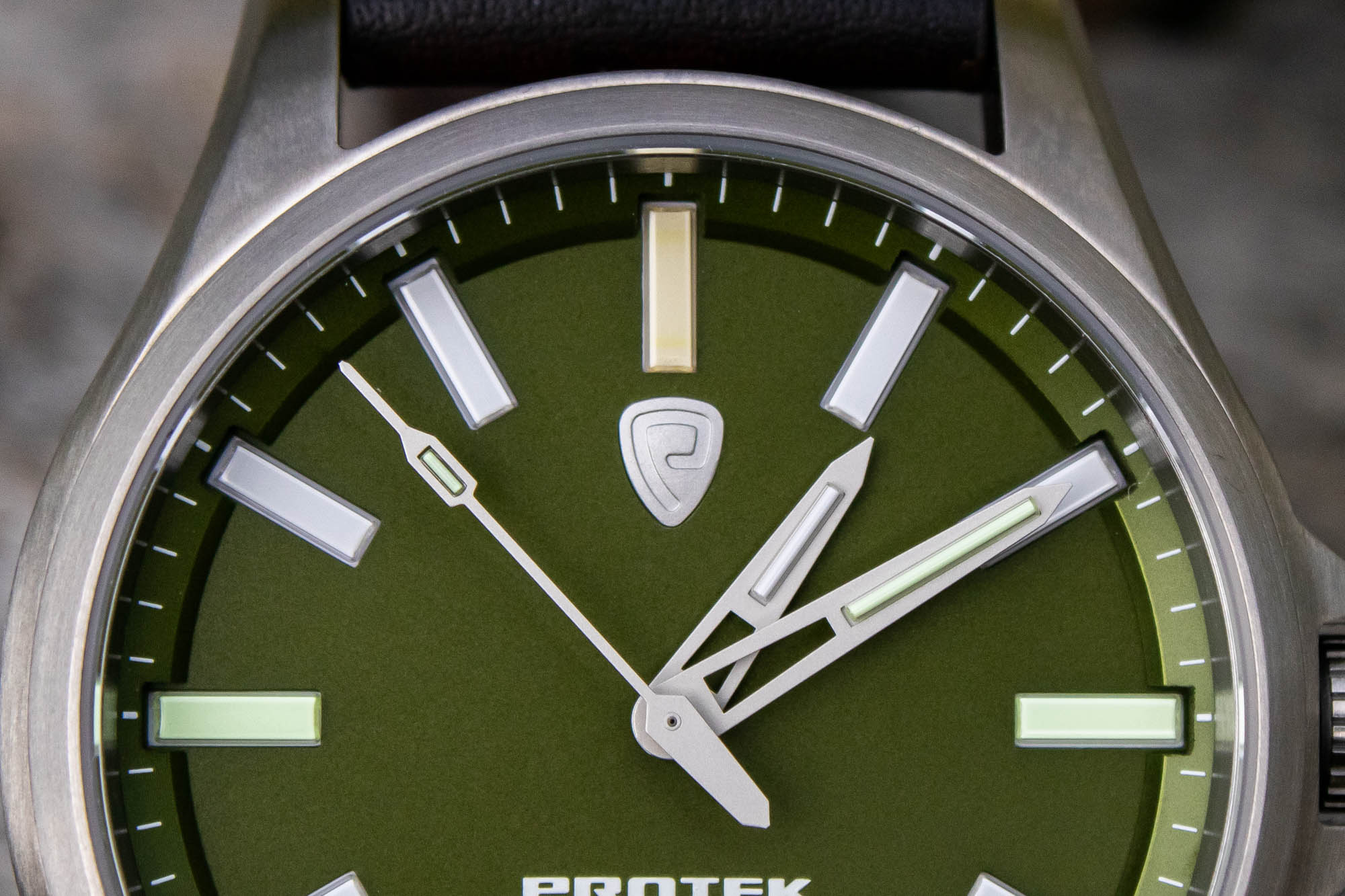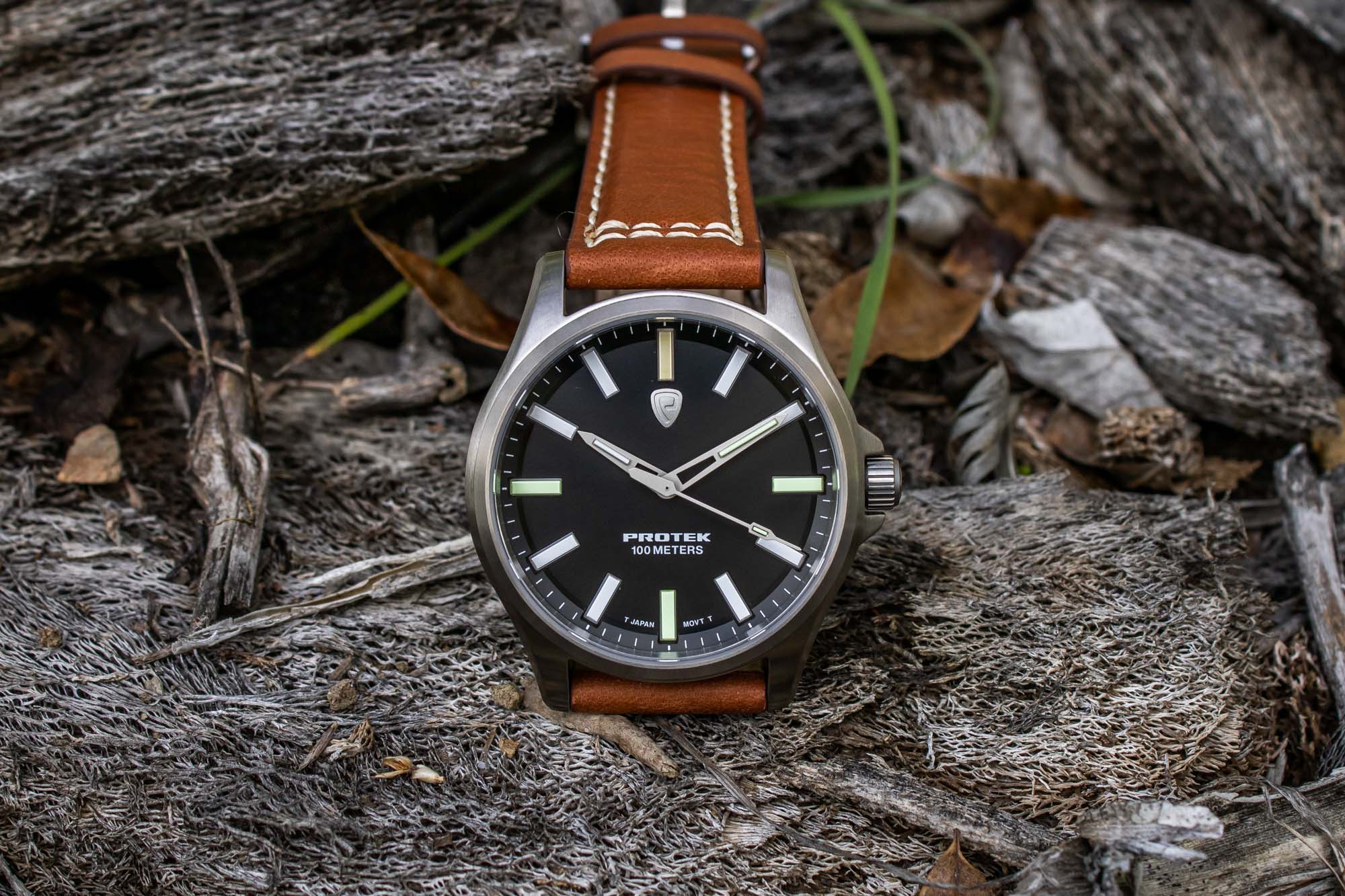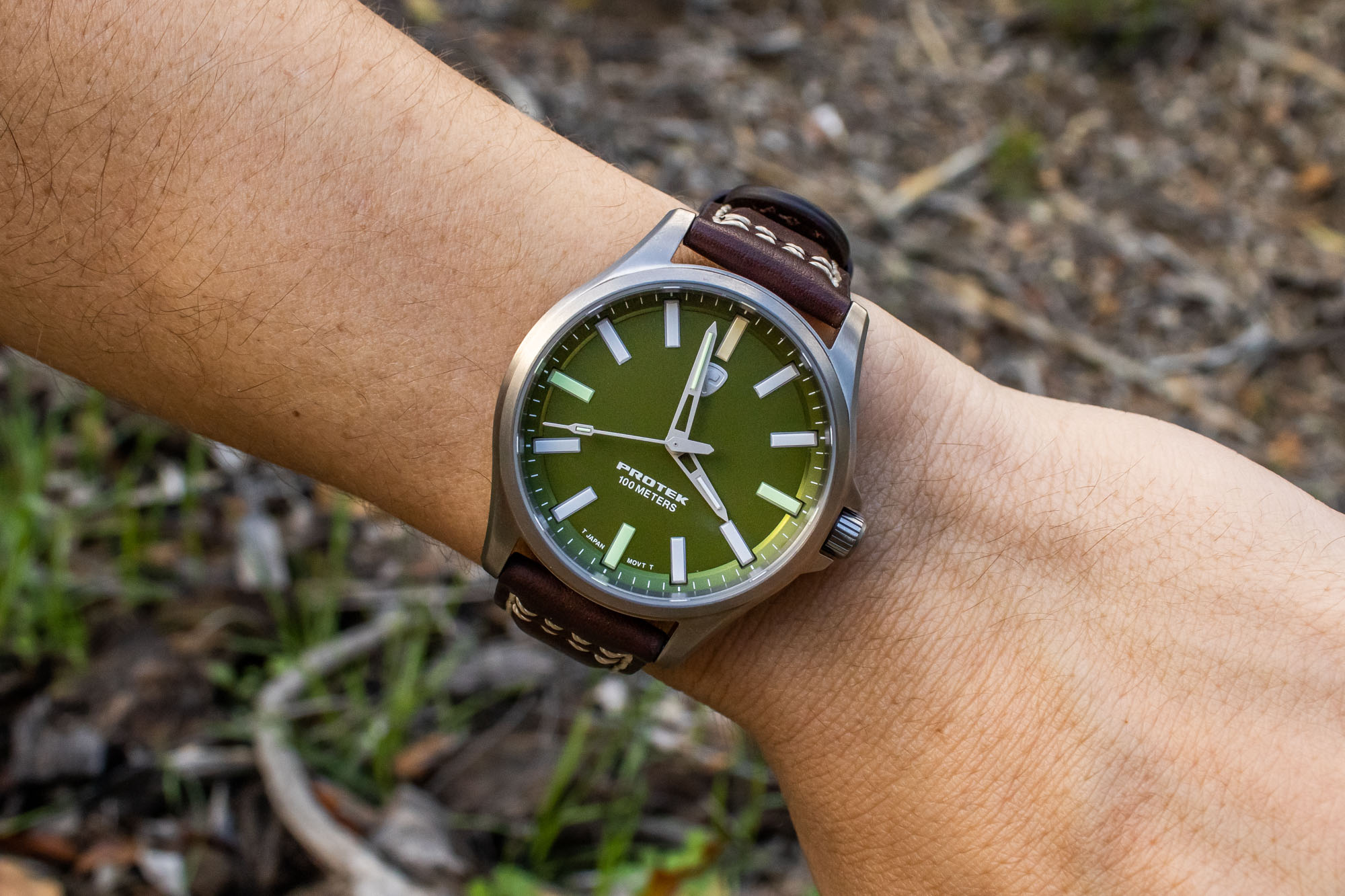
I first became aware of ProTek watches when I heard the brand’s founder Barry Cohen interviewed on an episode of the Superlative podcast. As the person who also founded the company Luminox, Cohen is often credited with bringing watches with luminous tritium tubes to the masses. After selling Luminox, Cohen turned his attention to his other watch company called Time Concepts, which serves as the parent for ProTek and a handful of other watch brands. Similar to Luminox, ProTek focuses on building rugged quartz watches with tritium tube illumination technology designed for law enforcement, first responders, and military personnel. However, ProTek aims to turn things up a notch within this category by using Cohen’s experience creating watches for the United States Marine Corps, and taking an uncompromising approach to materials and manufacturing. The ProTek Series 3000 is the brand’s range of field watches that pair a highly visible luminous tritium tube display with a durable and straightforward titanium case to create a simple grab-and-go timekeeping companion. Among ProTek’s various models, it is the Series 3000 that appeals to me the most. However, as someone who never actually had any hands-on experience with one of the brand’s watches, I was curious to check out the ProTek Series 3000 in the metal and see what exactly it brings to the highly competitive and densely-packed field watch landscape.
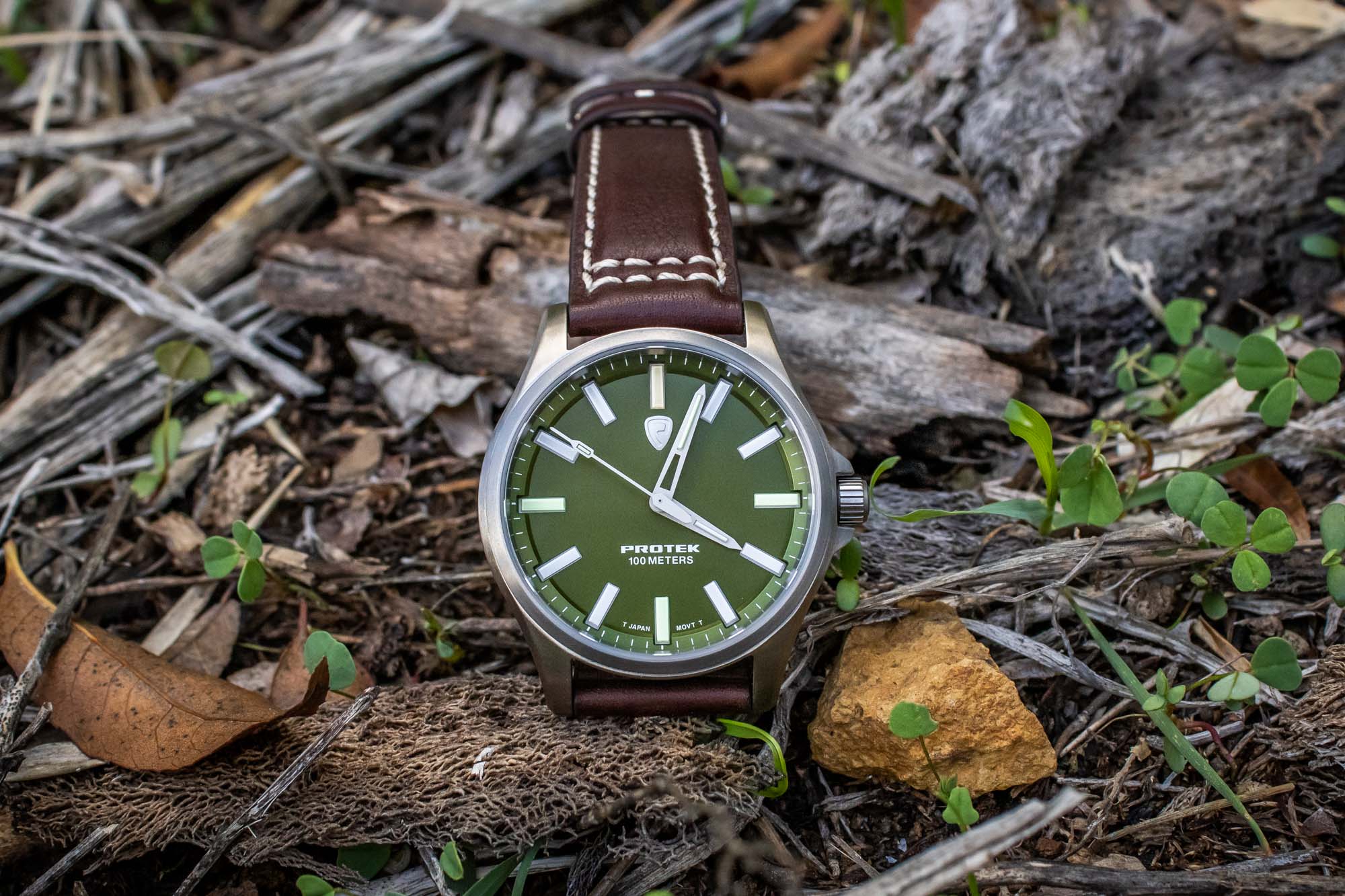
The case of the ProTek Series 3000 field watch is crafted from brushed titanium and measures 40mm in diameter by 11mm-thick, with lugs that are set 20mm apart and offer an overall lug-to-lug profile of approximately 47mm. The overall design of the case follows a classic round shape with thick beveled lugs, a thin fixed bezel, and small pointed crown guards that protect a signed push-pull style crown at the 3 o’clock location. The top of the case gets fitted with a flat sapphire crystal that has an anti-reflective coating, while the reverse side of the watch is protected by a solid screw-down titanium caseback that features a deep engraving of the ProTek logo. Although I would have personally preferred to also see a screw-down crown (especially considering the autonomy provided by its time-only quartz movement), the crown and tube do feature a multi-gasket system, and this means that the ProTek Series 3000 is water resistant to 100 meters, which should be more than enough given its intended purpose as an everyday field watch.
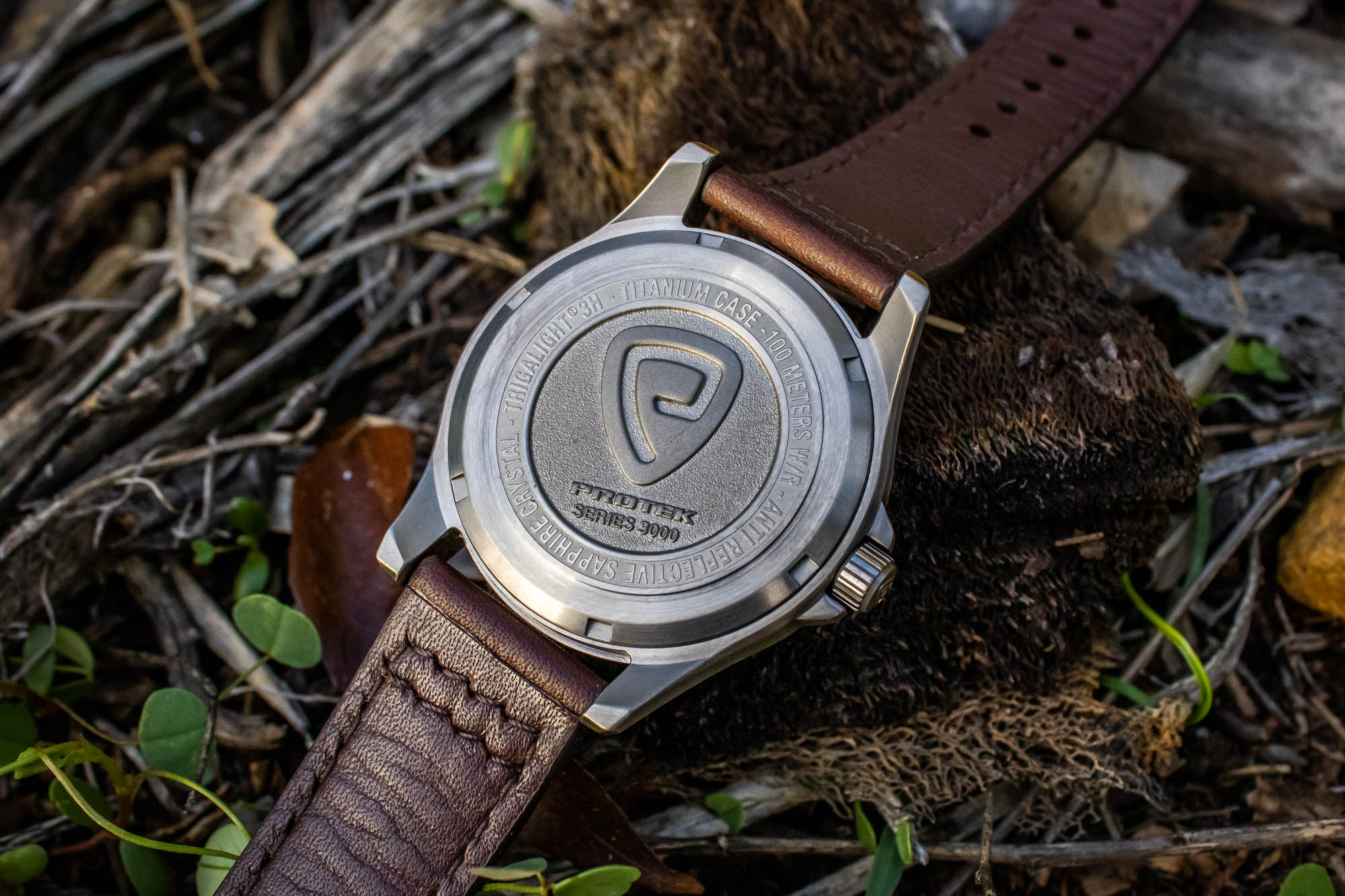
At the time of writing, the ProTek Series 3000 spans a total of five different models, with the primary differences between them being the colors of the dials and straps fitted to each of the watches. Two of the five models feature the same matte black dial, although one has a regular brushed titanium case and a light brown strap, while the other has a black-finished case with a matching black strap for a dark and stealthy overall appearance. The other three models that make up the ProTek Series 3000 field watch collection all have brushed titanium cases and are fitted with either blue, green, or off-white/silver colored dials, with the blue dial version featuring the same light brown strap that can be found on the black dial model, while the green and off-white/silver dial variations both receive dark brown straps.
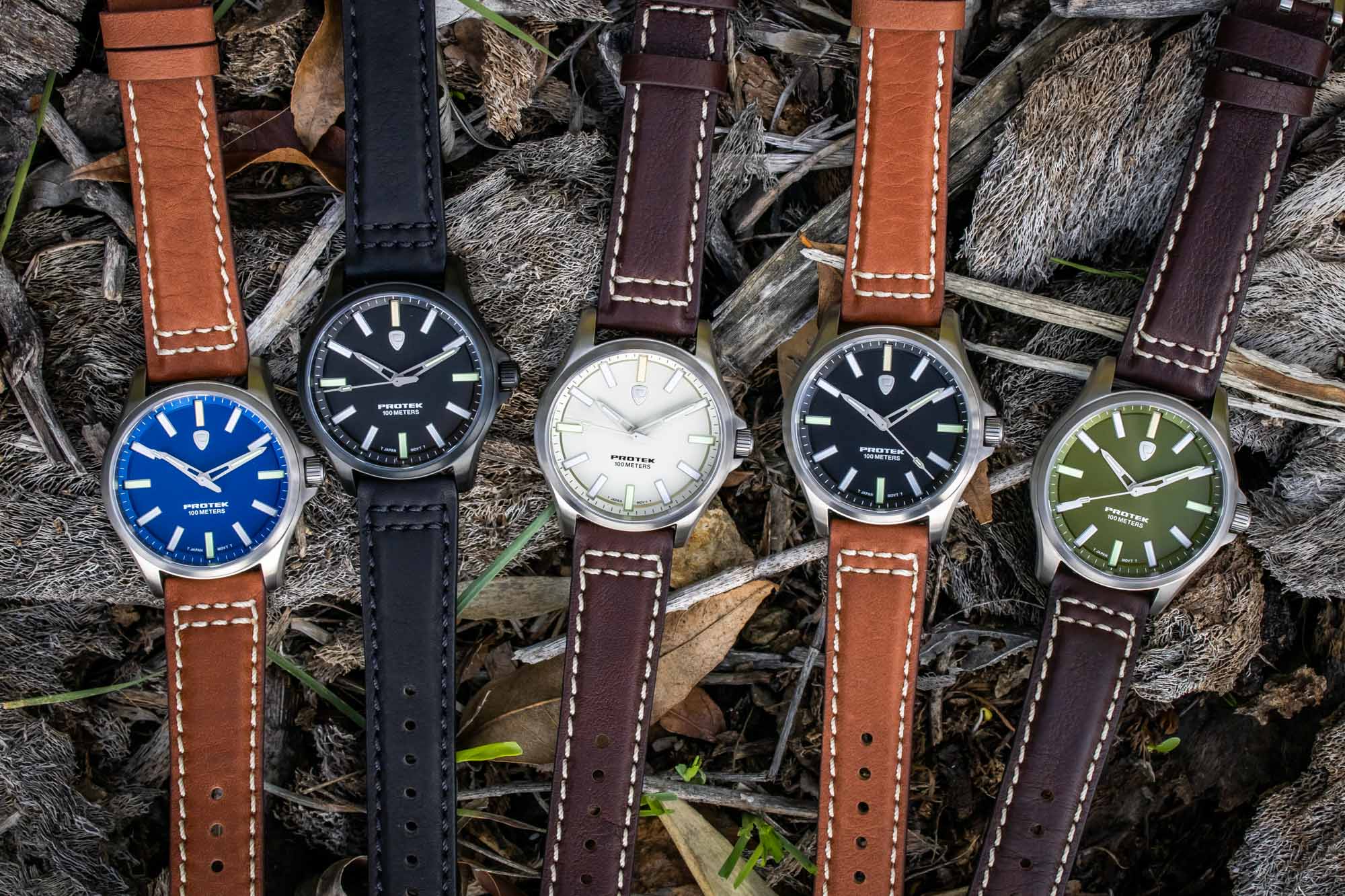
Regardless of their specific color, all of the dials follow an identical overall design, with a simple time-only display and large baton-shaped tritium gas-filled tubes serving as the hour markers. The tritium tubes themselves are recessed into the surface of the dial, while a raised and angled rehaut contains a printed minute track and features cutouts for each of the tritium tubes to offer additional support and help create an integrated overall appearance. Below the 12 o’clock marker sits ProTek’s shield logo as an applied element in matte silver, while the lower half of the dial features the ProTek name, along with an indication of its 100-meter depth rating. The only other writing on the dial of the watch is the small “JAPAN MOVT” text by the 6 o’clock hour marker, which is flanked by two small “T” symbols to denote the use of tritium for its gas-filled luminous tubes.
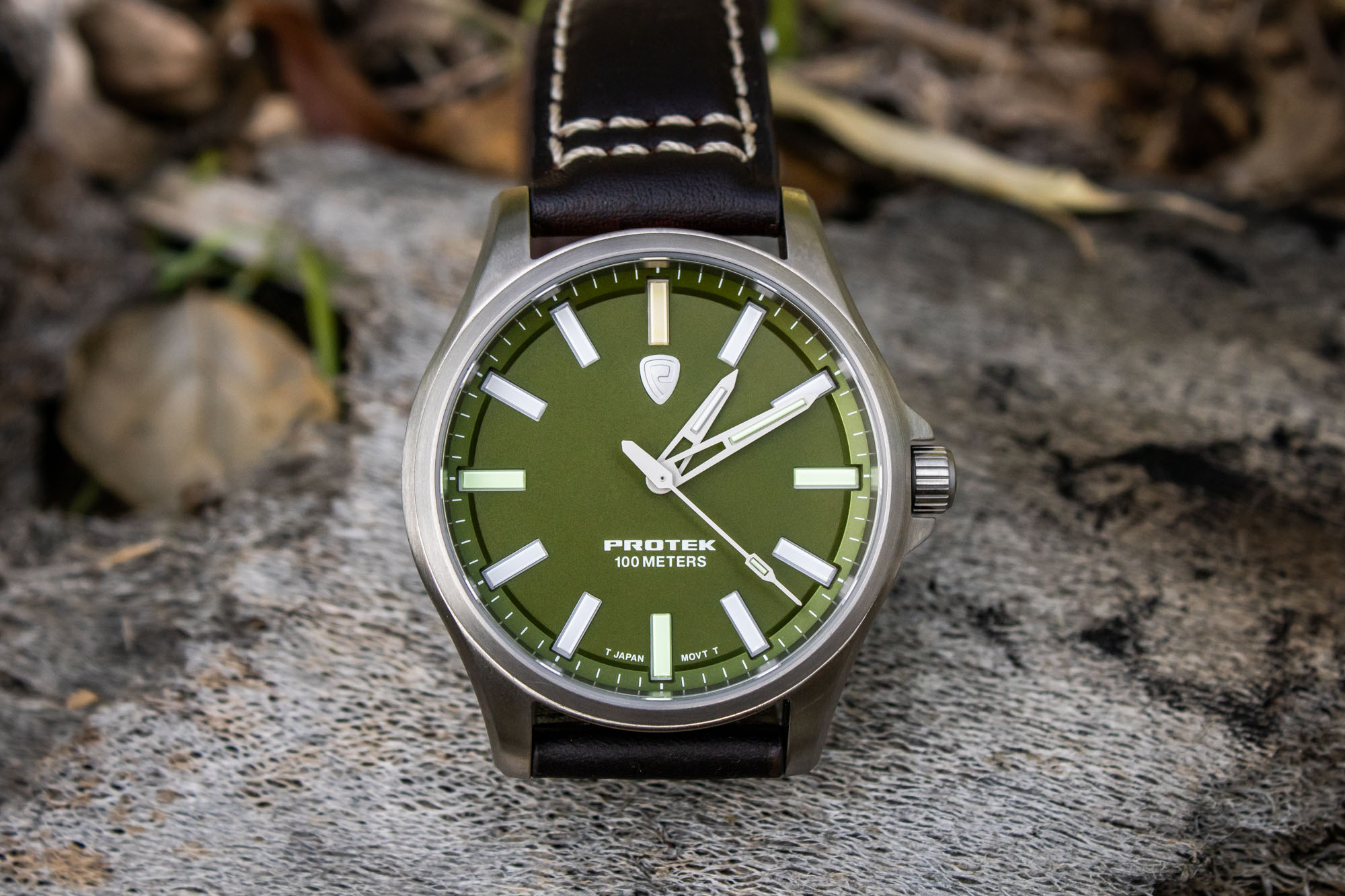
At the center of the dial are a trio of hands, with the hour and minute hand appearing in a skeletonized angular dauphine shape, while the thin seconds hand features a luminous tip and prominent counterweight that echo the shape of the other two hands. While legibility isn’t an issue at all, I personally would have preferred the minute hand to be slightly longer (or the rehaut larger) so that the tip of the hand could reach all the way to the markings of the minute track. All three of the hands are set with luminous tritium tubes, with the minute hand and seconds hand receiving green-glowing tubes, while the hour hand glows blue for added contrast in the dark. Similarly, the tubes for the hour markers also glow different colors to offer a clear orientation in low lighting, with an orange-glowing tube at the 12 o’clock marker, green-glowing tubes at the other cardinal points, and blue-glowing tubes for the rest of the markers. Officially known as ProGlo on ProTek watches, the tritium tubes use Trigalight technology, and due to the large size of the tubes themselves, the ProTek Series 3000 watches offer an incredibly clear display of the time in complete darkness. Additionally, due to the radioactive nature of their tritium-based luminous technology, the tubes on the Series 3000 will offer a bright and continuous multi-colored glow for up to 25 years that does not require any light exposure at all in order to “charge” its luminescence.
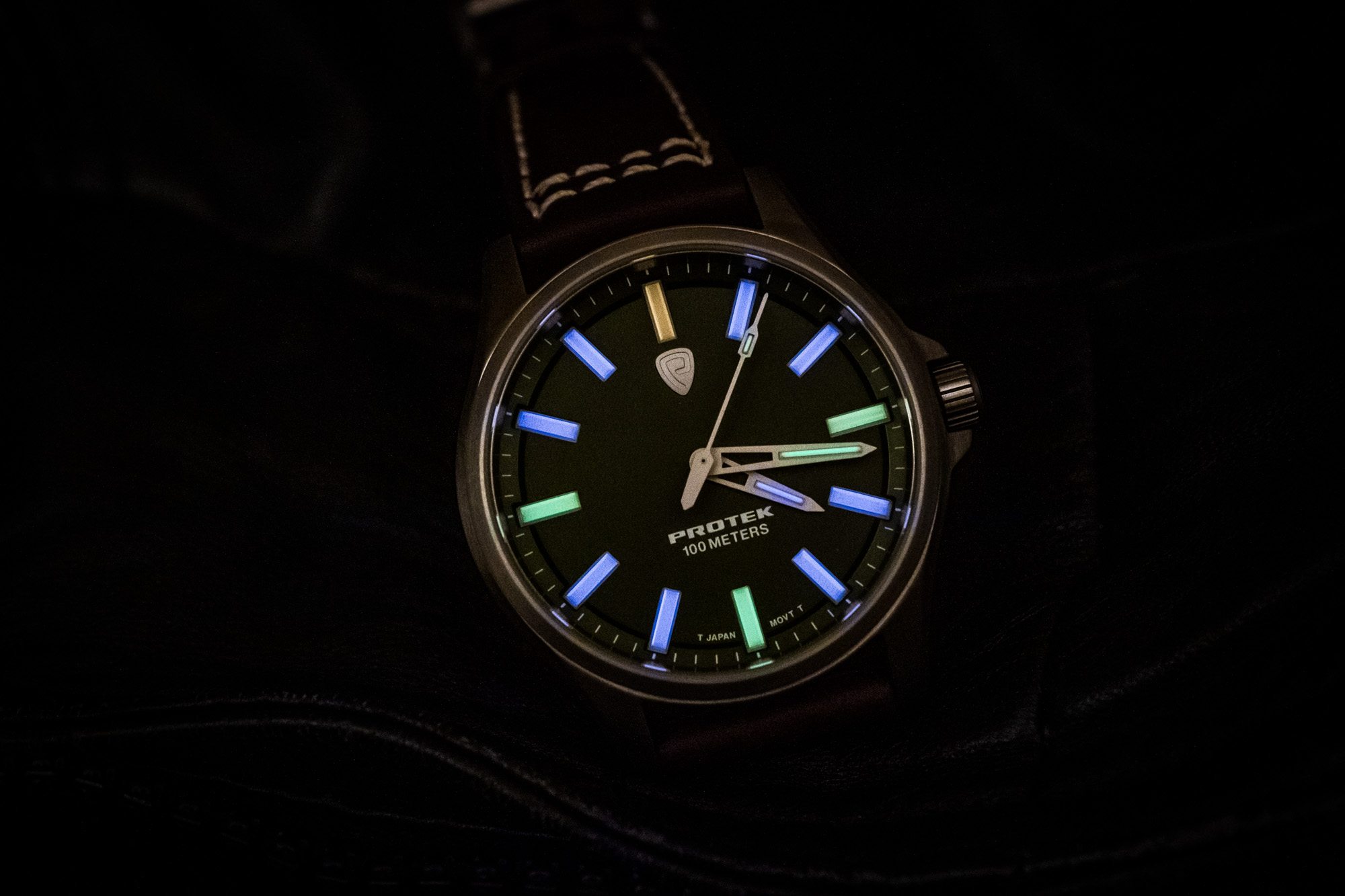
Driving the three hands of the ProTek Series 3000 field watch is the Miyota Super 2035 quartz movement. Offering an accuracy rating of +/-20 seconds per month with a battery life of approximately four years, Miyota’s Super 2035 is very much a known quantity that is used in countless different watches throughout the industry. Despite the fact that they are rather ubiquitous and can be found in numerous budget-friendly timepieces, the use of Miyota quartz calibers was very much an intentional decision on the part of ProTek. In the Superlative podcast episode that featured Cohen, he explains that while they may not be the most impressive from a horological standpoint, Miyota’s quartz movements are insanely reliable, and in all his time working with watches, it was the Miyota quartz calibers that ultimately proved to be the least problematic. While the watch enthusiast in me would have still liked to have seen something Swiss or possibly even a solar-powered movement, a watch that requires regular light exposure kind of goes against the whole concept of tritium tube technology, and opting for a Miyota caliber does mean that the movement can easily be swapped out for a new one at minimal cost should any issues or damage occur down the road.
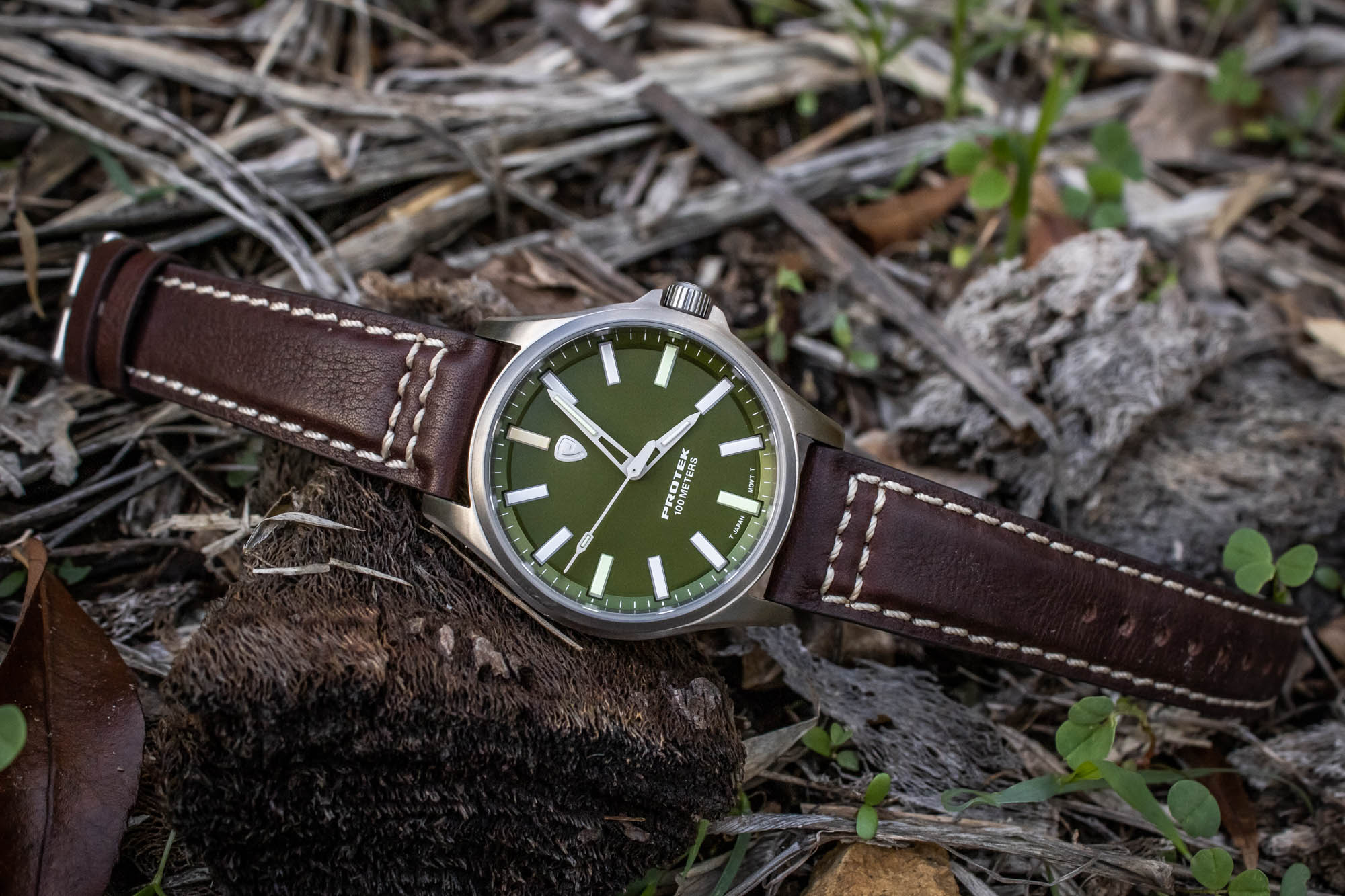
Similar to the dials, all of the straps fitted to the various ProTek Series 3000 watches feature an identical overall design, regardless of their specific color. Crafted from genuine Italian leather, the brown versions of the strap all feature white contrasting stitching and chunky brushed titanium pin buckles, while the stitching on the black version is done in a matching shade of black (as is the finish on its titanium buckle) in order to maintain the all-black profile of the watch. Tapering from 20mm at the lugs to 18mm where they connect to their buckles, the straps for the Series 3000 feature a small amount of internal padding and offer a very traditional overall design. That said, what is most interesting about these straps is that they are listed as being waterproof. While a number of leather straps make similar claims, ProTek fits a version of these leather straps to some of its dive watches, so I figured that whatever water-resistant technology they were packing, the brand had to be fairly confident in its abilities. Even still, I was curious about how ProTek’s leather straps would respond to water, so I figured that I would do a bit of testing.
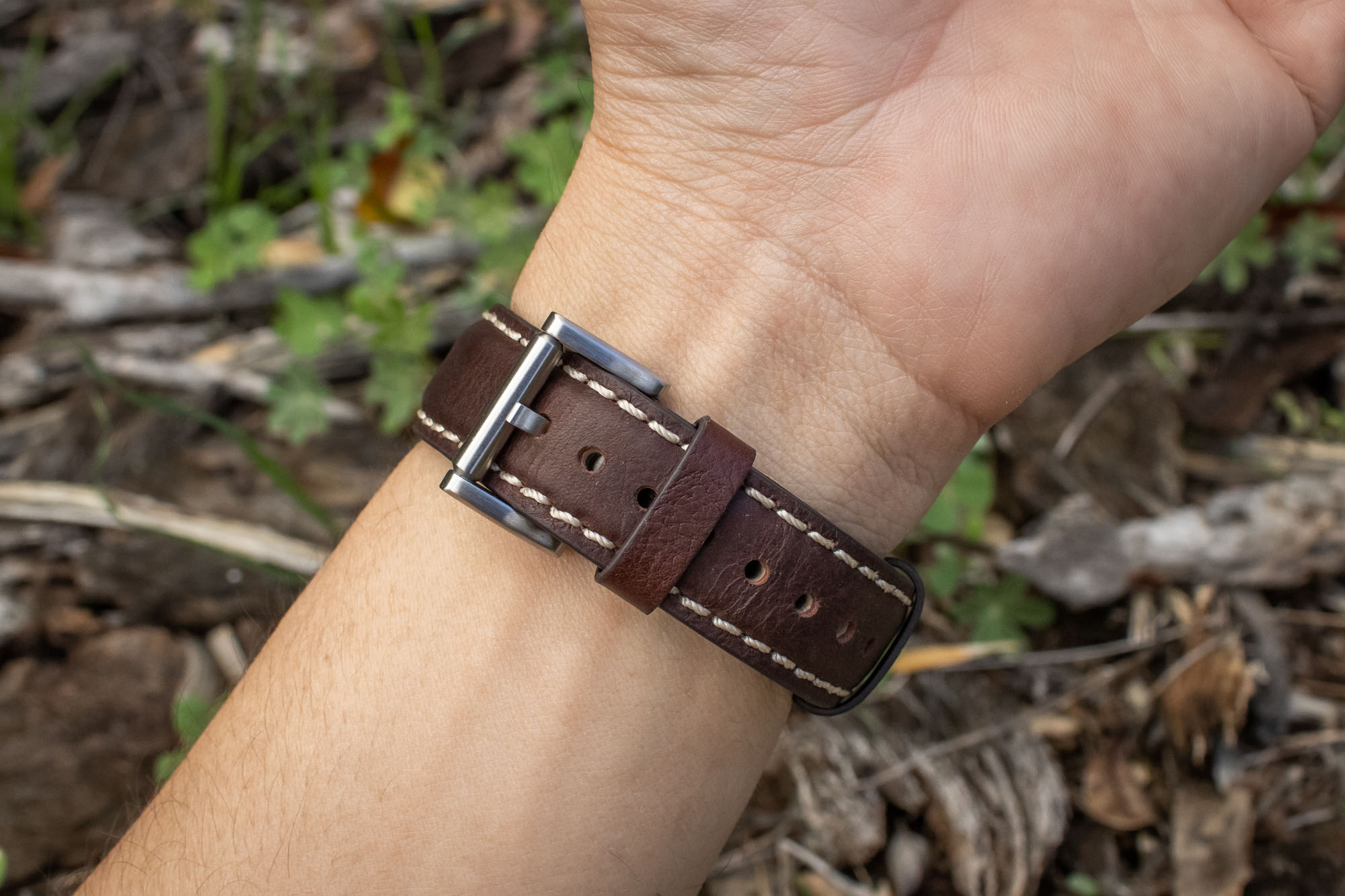
I wore one of the Series 3000 watches over the sleeve of my jacket while walking my dog during a recent rainstorm in Los Angeles, and I could see it getting visibly wet and slightly changing color as it became covered in water. That said, the rain stopped before I got home and by the time I had a chance to examine it, it was completely dry and back to its original appearance. To further explore what exactly happens when the leather strap comes into contact with moisture, I rather scientifically shoved the watch into a glass of water and left it there for an hour. Upon removing the watch and wiping off the excess moisture, the outer surface of the strap felt slightly damp, although the strap itself didn’t at all feel water-logged or soggy, and within about ten minutes of being on my wrist, you wouldn’t have been able to tell that it was previously submerged in water. While I still might opt for something like a rubber strap or a NATO if I knew that I was going to be spending the day at the beach, I would have zero hesitations about wearing one of the Series 3000 watches on its standard leather strap for rainy day hikes or the occasional impromptu swim.

All things considered, the ProTek Series 3000 represents a highly practical and functional overall package, although, with an official retail price of $475 USD, it does initially seem slightly expensive. You can get a titanium field watch powered by a mechanical movement for less money these days, although it’s important to remember that the Series 3000 uses tritium gas-filled tubes, and it should therefore be viewed within the context of other watches that offer a similar type of luminescent technology. While the absolute least expensive options from both Luminox and Marathon start out at around $300, if you want a watch with a metal case, you will be looking at nearly $600 for either brand’s most affordable offerings. While that extra money does get you the bragging rights of having a Swiss movement, neither option is crafted from titanium like ProTek’s Series 3000 field watch, and so I ultimately have to accept that my initial impression of it seeming a bit expensive is simply the knee-jerk reaction to seeing this price attached to a watch with a quartz Miyota caliber. Movement prejudices aside, give the ProTek Series 3000 a screw-down crown along with a slightly longer minute hand, and there would be little else left that someone might want to change about it, and it’s undeniable that the watch offers a simple and refreshing pared-down aesthetic compared to the overtly military-inspired designs of many other watches with tritium tube luminescent technology. For more information on the ProTek Series 3000 field watch, please visit the brand’s website.

